On this particular website I would like to share with you my experiences in the propagation of tuberous Drosera. I will talk about the practical things like tubers, seeds, leafcuttings, dropper roots a.s.o.
Propagation with Tubers
The easiest way to propagate tuberous Drosera is via tubers. This is because the only thing you'll have to worry about is meeting the conditions for good growth of mature plants, stated above. At the end of the growth period, when the above ground parts of the plants are dying, one larger tuber is usually formed along with some little, small secondary tubers.
Depending upon the species, varying amounts of small or large tubers will be formed or not. One day I got one adult tuber of Drosera menziesii. 5 year later, I dug out 40 tubers of different size. On the other hand I got a tuber of Drosera rosulata. Year by year the tuber has more or less the same size, but it never formed additional tubers and it did not flower.
Of course, the formation of additional tubers depends on how much energy the plant have and on the conditions. As expected, providing your plants with better conditions and feeding them regularly will increase the likelihood of obtaining material for propagation, such as seeds, offshoots, or small tubers.
Some guys are lucky! Left is a picture of Drosera zoneria of Jean-Pierre and on the right the same plants short time later.
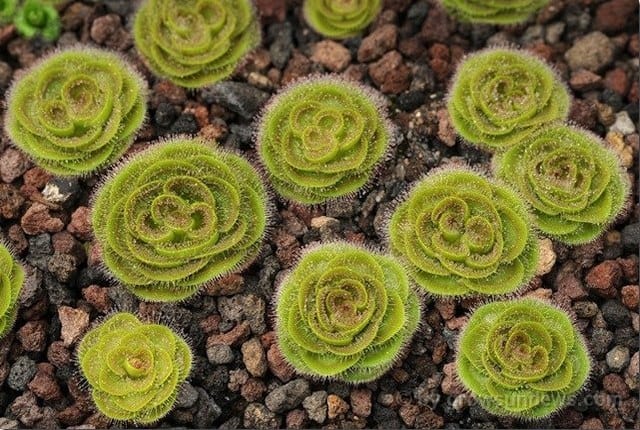
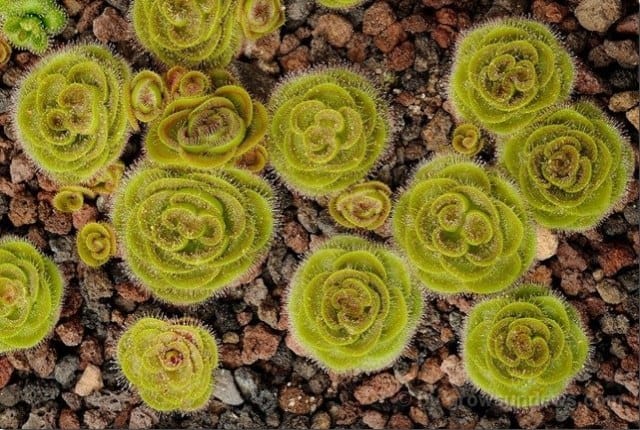
Propagation with Seeds
Apart from tubers, seeds are another way of propagating tuberous Drosera. While it can be quite tricky to germinate some tuberous sundew species (sometimes taking over 3 years for the more difficult species), seeds have the advantage that all the resulting plants will be genetically different. If you want to obtain seeds from your tuberous Drosera, this is important to consider, since most tuberous Drosera need to be cross-pollinated with genetically different plants of the same species in order to produce seeds (or with a different species that is compatible, which will sometimes create a hybrid). If you have multiple plants that were formed from the same parent or if one plant is the off-shoot of the other, then cross-pollination will usually not work.
Pollen
The problem is to obtain pollen from a genetically different plant. On the one hand, you may only have one plant or genetically identical plants because they come from daughter tubers, for example. On the other hand, it is possible that one plant blooms, the second one, with whose pollen you could pollinate the plant, will only open in a few days.
In this case, you can remove the pollen from the plant with a pair of tweezers, for example, and store it for later or exchange it with others who have the same problem. An inquiry in a carnivore forum can help a lot. The pollen usually lasts about two weeks and should be shipped immediately or stored in the refrigerator. For this purpose it is best to use small bags of parchment or parchment. It is best to cut off the whole flower. You should always pluck the petals from this flower, because it is very difficult to use the pollen when it is dry.
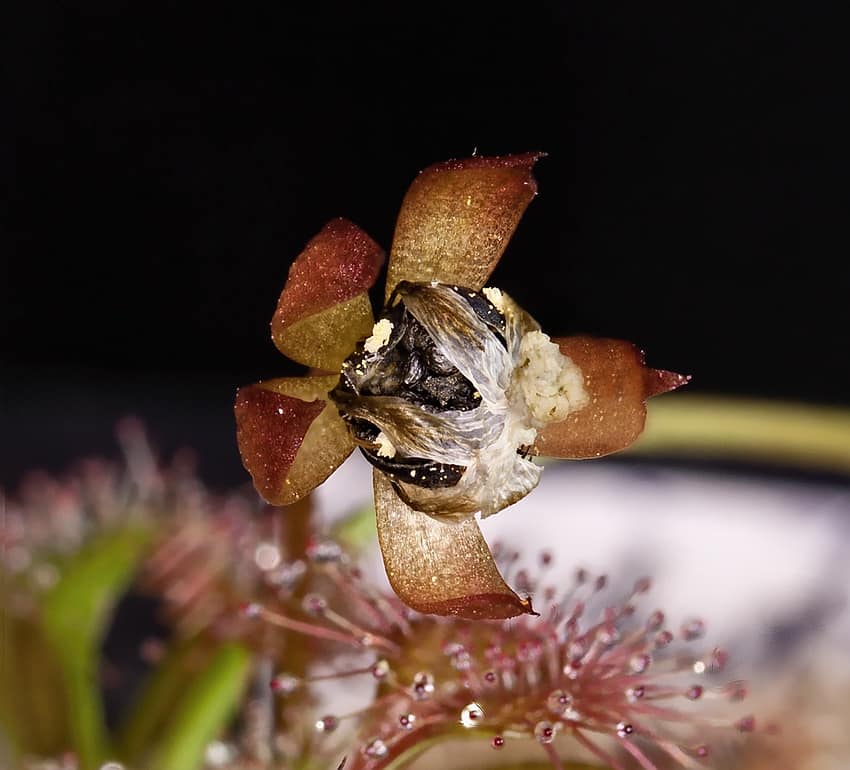
Drosera schmutzii with seed vessel
Germinating Tuberous Drosera Seeds
Seeds of some species needs a hot stratification to grow, that means that they have to be treated to simulate summer conditions so that germination occur. Seeds of Drosera macrantha, Drosera peltata, Drosera hookeri, Drosera erythrogyne and Drosera auriculata don't need stratification.
The best time to sow seeds of these species is from August to September. About one month after sowing, the average daytime temperatures should be kept under 20°C (70°F). Keep the seeds wet and with natural (shortening) day length. Seeds will germinate when the photoperiod and the temperatures are appropriate, mainly from October to December. I always keep the pots closed with cling film.
Hot Stratification of Tuberous Drosera Seeds
In nature, the seeds of tuberous Drosera will remain for at least one season on the hot surface of the ground, where occasionally bush fires break out because of the hot and dry climate. It seems that nearly all species of tuberous Drosera require these hot temperatures and bush fires in order to germinate.
Again, the key to successfully cultivating of tuberous Drosera is to closely mimic the conditions tuberous Drosera are subjected to in nature.
Option 1:
Sow them in June and keep them dry and hot (at least about 30 °C (85 °F)) in the full sun until mid-end of September. Then keep them wet and at natural (shortening) daylight. Seeds will germinate when light period and the temperatures are appropriate, mostly from October to December. That is the easiest method for small seeds usually from erect species. I sow the seeds, put a clear film onto the pot and put them onto the terrace into the full sun whole summer long.
Option 2:
Store the seeds from August to mid-September at around 30°C (85°F) before sowing them. Then keep them wet and at natural (shortening) daylight. Seeds will germinate when light period and the temperatures are appropriate, mostly from October to December. I used this method for some years but the difficult seeds did not germinate and the easier one work fine with option 1.
Option 3:
Pack the seeds in some "tea-bags"-like material and put it into hot water. Therfore fold small envelopes out of filter paper from the coffee machine. Don’t forget to label the filter paper.
Now burn some plant debris. I use the dried parts of the tuberous Drosera, which I collect or anything else in the garden. Extinguish the fire with hot water and filter off the larger remains for instance through a coffee filter. Wait until the water has cooled down to about 60 °C (140 °F). Then put the seedsbags into the hot water for 30 to 60 seconds. You can sow the seeds right now, but it is easier to sow them when you first let them dry. Sow the seeds and keep them wet and at natural daylenght. Seeds will germinate when light period and the temperatures are appropriate, mostly from October to December. This works with the more difficult seeds which have a thick cover like the most rosetted species. I did not try to leave the fire part out. I expect it should work as well, but that remains to be shown.
Option 4:
I am sure there are more options especially for bigger seeds, which usually are not so easy like D. ramellosa, D. humilis a.s.o. like soaking with GA3 (Gibberellic acid, a plant hormone that stimulate rapid root grow and increase seed germination rate) or treating them with sodium hypochlorite or hydrogen peroxide, but those are the ones I use and which I find quite easy to use even with larger numbers of seeds/species.
Self Pollinating Tuberous Drosera
There are a few species of tuberous drosera which are known to be self pollinating and form viable seeds. Usually not all plants of a species and even not all plants of a location or of one clone are always self pollinating. Here is a picture of some of my Drosera lowriei from Holt, Western Australia. I have alltogether 9 plants from in vitro culture in the pot which are all from one plant so the plants are identically clones. I had all together 5 flowers. As you see on the picture 4 of this 5 flowers had swollen seeds vessels. Because I did not pollinate them it seems that they are self pollinating and 2 trustable growers said, that they saw the same with tubers from the same in vitro culture.
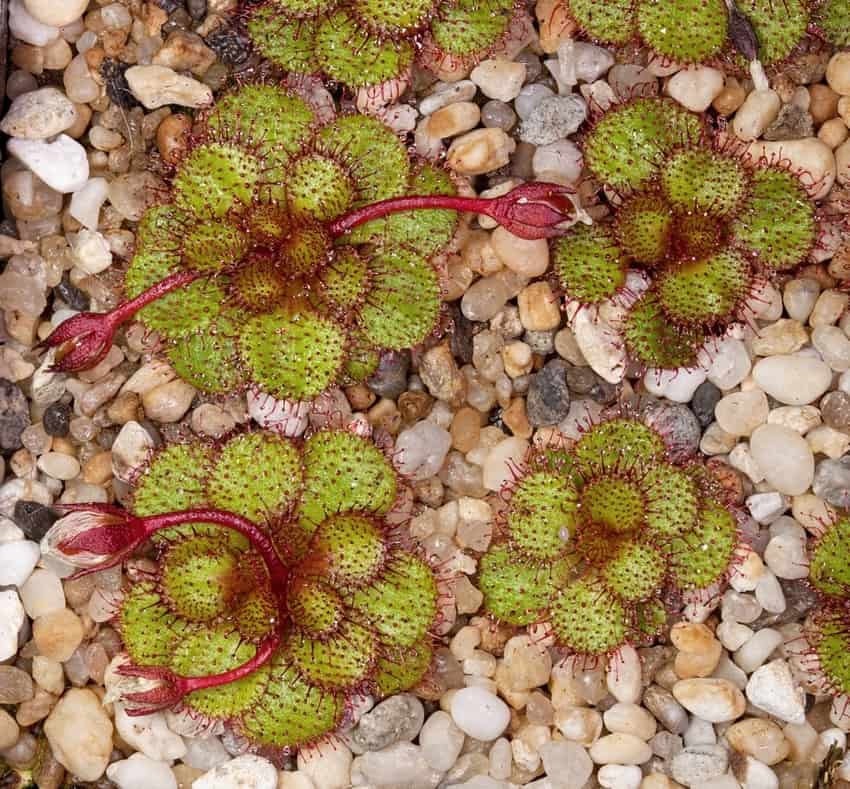
Drosera lowriei with self pollinated seed vessels.
Here is a small list of tuberous Drosera species from which is known that there are at least some clones which are self pollinating:
D. lowriei, D. planchonii, D. ramellosa, D. bicolor, D. auriculata, D. peltata, D. salina, D. stricticaulis, D. yilgarnensis.
Dropper roots
Some species of tuberous Drosera develop "dropper roots". That are roots which are builded above the ground from the leaves or the leaf axix. They slowly grow until they reach the ground and than into the substrate. Later in the season this dropper roots sometimes build additional tubers but usually very small ones so you have to take care. The known species are D. gigantea, D. intricata and D. radicans. Especially D. gigantea forms only roots when the humidity is very high (about 60 % and higher).
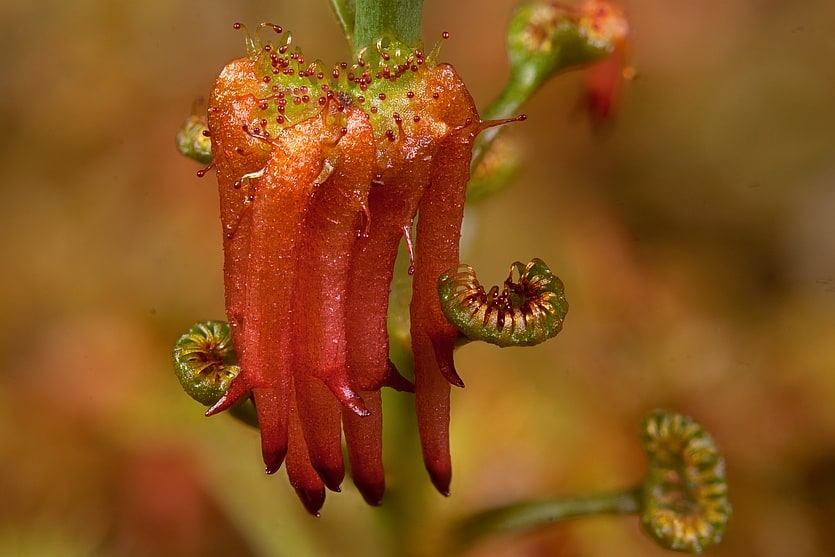
This is not a carrot tree ;-). Leaf of Drosera gigantea with dropper roots
Leaf Cuttings
For years it was told that there is only one species of tuberous Drosera, Drosera auriculata, with which successful leaf cuttings have been reported. That changed a little bit in 2018. There was an article in the CARNIVOROUS PLANT NEWSLETTER from march 2018 by Robert Gibson. He wrote there about the propagation of some tuberous Drosera by leaf cutting. He successfully propagated Drosera gigantea, Drosera sulpurea and drosera peltata by leaf cuttings. Some guys and I started to make some experiments and here are the tuberous Drosera species which couldt be progagated by leaf cuttings:
Drosera gigantea, Drosera sulphurea, Drosera peltata, Drosera auriculata, Drosera myriantha, Drosera radicans, Drosera abberans, Drosera whittakeri
The technique is the same then it is used for other Drosera leaf cuttings. A leaf is cut as close as possible to the stem and placed in a container on a very moist medium. The medium can be so moist that the leaf almost floats in the water. The stem of the leaf should be under water or in the medium. The container is closed with transparent film and some holes are made into the film. The whole is put to the other tuberous Drosera. From time to time you shloudt have a look and possibly pour in some more liquid.
After some weeks it shloudt or couldt look like this:
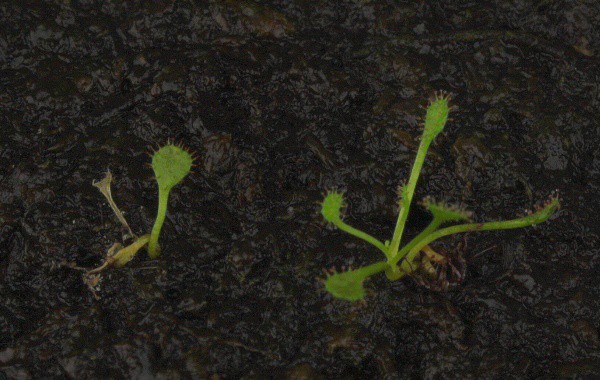
Drosera radicans leaf cutting after about two months
Root Cuttings
This works with some Drosera but it seems that root cuttings are not possible for tuberous Drosera. I've never heard about anyone doing this successfully. Therefore, I would strongly discourage taking root cuttings from tuberous Drosera, since you will probably end up harming the plant.
Stolon Cuttings
It seems possible to propagate tuberous drosera with stolon cuttings or better breakings. I heard at least from one trustable grower, that a stolon, which broke from a tuber by accident when he wanted to pot the tuber, grow to a new plant plus another one from the remaining tuber. Another trustable grower said that he used stolons for propagating tuberous sundews by in vitro culture.